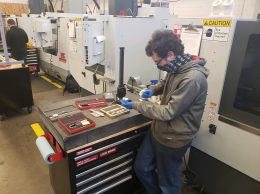By John K. Paglia on June 29, 2012
On June 1, the federal government released surprisingly bleak job numbers for the United States. With only 69,000 jobs added in May, the national unemployment rate rose to 8.2 percent. In California, the joblessness rate remains a stubbornly high 10.9 percent.
Closer to home the numbers are better — the Central Coast’s unemployment figures range from 7.7 percent to 8.9 percent. However, those numbers are still roughly double the 4 percent to 5 percent unemployment rate we enjoyed for much of the early part of the last decade. Long-term economic growth for the region is far from certain.
The fact is, small-business hiring is the most direct path to job growth and sustained prosperity for the Tri-Counties. However, one major obstacle remains: access to capital.
In large part, the inability to grow is due to limited access to financing that could allow private businesses to hire more employees, expand their space or expand their product lines.
Seventy-five percent of California businesses that responded to the Pepperdine Private Capital Markets Index survey released in May said it will be difficult to raise both debt and equity financing in the next six months. Of the businesses planning to raise capital, 74 percent said unsuccessful attempts to secure financing will result in slower business growth and 59 percent said they will hire fewer new employees than planned.
This problem is not limited to the Central Coast or California. National data collected revealed that, among the 5,997 survey respondents, 64 percent of businesses with revenues under $5 million said difficulty in securing financing is limiting their growth potential and 55 percent said it is restricting plans to grow their workforce.
The inability to access financing has significantly hindered the state’s businesses to create and add jobs. Without business growth and job creation, California and the Central Coast region will continue to slog through a recessionary environment. The following steps should be taken to improve the flow of capital:
1) Central Coast business owners need to be educated about what types of capital are available, what type of capital is appropriate for their business and where they should go to get it.
The U.S. Small Business Administration and California’s Small Business Development Centers should take a leading role in educating small business owners. With small businesses continuing to expand their search for capital, it is imperative that they understand the expansive private capital markets. From angel investors (conveniently located in nearby Silicon Valley) to regional banks, if small business owners are armed with information about lending criteria, capital requirements and lending process, they can more effectively allocate resources to investigating new capital.
2) Capital providers must increase transparency. Transparency is the key to improving the success of those seeking financing. Currently, many deals are negotiated in a vacuum and there is very little data available for other businesses that are in the market for capital.
If businesses are not able to accurately assess their ability to raise capital, they could needlessly spin their wheels when they could have been focused on improving their balance sheets. Already, regional and community banks like One Pacific Coast Bank have caught on and are emphasizing transparency in how they market business loans.
3) Finally, Congress and the California Legislature should investigate ways to develop public-private partnerships that will incentivize investment. States such as Tennessee are offering future tax credits to invest in companies within the state.
In Tennessee, the state offered $200 million in gross premium tax credits for future years’ use to insurance companies that invest in businesses qualified by the state of Tennessee as a “TNInvestco.” Similar programs that offer incentives to businesses in which the Central Coast already has a solid base — health care, life sciences, technology — would bring higher-paying jobs to the region.
Scarcity of credit for small businesses continues to hinder our local and national economy. When conducting business valuations I meet many business owners that dearly want to expand and hire new employees but cannot find the capital. My research backs up anecdotal evidence showing that businesses are not gaining access to the capital they need to grow.
Through education, transparency and innovative programs, our leaders can propel the Central Coast’s economy forward.
• John K. Paglia is an associate professor of finance at Pepperdine University’s Graziadio School of Business and Management. He also is director of the Pepperdine Private Capital Markets Project. To download the study at no cost, click here.






 Print
Print Email
Email

















